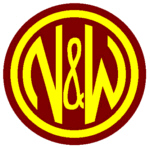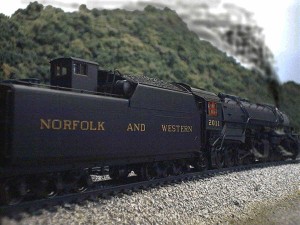- Size: 11′ x 20 ′
- Scale: HO
- Minimum Radius: 30″ (except as noted on tail tracks)
- Minimum Aisle Width: 33″
- Designed by Dan Bourque
 Jenkinjones, West Virginia was a company town that lay at the end of the N&W’s Tug Fork Branch, almost to the border with Virginia. Toward the end of the steam era, Jenkinjones was home to three tipples that all loaded company coal from the Pocahontas #3 seam. The tipples were reached via switchbacks after a grueling climb up 2.5% grades making this a tough piece of railroad to operate.
Jenkinjones, West Virginia was a company town that lay at the end of the N&W’s Tug Fork Branch, almost to the border with Virginia. Toward the end of the steam era, Jenkinjones was home to three tipples that all loaded company coal from the Pocahontas #3 seam. The tipples were reached via switchbacks after a grueling climb up 2.5% grades making this a tough piece of railroad to operate.
The Layout
This track plan represents Jenkinjones in the 1940s-50s when all three tipples were operating and N&W Y-class Mallets (2-8-8-2s) were the standard mine run power. It’s a relatively large layout that covers one town, so it’s designed for the modeler who really wants to capture one small area well. The design of the layout features all three tipples and the switchbacks to reach them, and it includes key scenic features such as the large wooden trestle that crossed the town to reach the Jenkinjones No 8 tipple along with the rows of company houses squeezed into the Tug Fork valley along with the tracks and stream.
Track arrangements for the No 6 and No 7 tipples are based on a right-of-way map and are compressed but fairly accurate. The track arrangement for No 8 appears to be similar to No 7 in aerial photos, though both tipples have been compressed from 5 loading tracks to 4. Staging consists of four stub tracks under No 8 representing Wilcoe Yard, the home for mine runs on the Tug Fork Branch. Each track is long enough to hold a Y-class Mallet, caboose and 25-30 55-ton hoppers. Because only one mine run would be used at a time, this layout could easily be wired for either DC or DCC, though walk-around throttles would be a must, and DCC may facilitate better locomotive sound (a must for the steam era).
This design also incorporates the prototypical 2.5% grades on the main and switchbacks which allows for the vertical elevation necessary to capture the scenes of tipples high up on the hillsides over the main. The layout is designed to be relatively low to accentuate the feeling of looking down into the valley from the surrounding hilltops. The grades also necessitate a lot of “handbrakes” to keep cars in place once spotted at the tail tracks or under the tipples. This layout would benefit from an “engineer’s touch” to figure out a way to make practical handbrake mechanisms in all the right places, and if a mechanism could be devised to slow the cars to control their descent without stopping them in certain areas, it would allow for more prototypical operations (see the “operations” section for details).
Operations
This layout is designed for 1-2 operators and could keep them busy for a couple of hours. I don’t have exact details on how this area was worked, but based on track capacities and grades, it probably would have taken at least 2-3 mine runs daily when the mines were producing at maximum. On the layout, each mine run would leave Wilcoe behind a Mallet with about 15-30 cars and a cab and head for either Jenkinjones No 8 or Jenkinjones No 6. placing the empties would be easy by simply hauling cuts of hoppers onto the tail track and shoving them up into the empty tracks above the tipples (don’t forget to tighten the handbrakes before uncoupling!). The cab could then be placed on a cut of loads at the tipple (this will make sense in a minute). Assembling the loads is another story. A look at track charts and topos reveals there aren’t any run-arounds in the area, and I doubt crews would back down a 2.5% grade with 30 loads of coal in front of them. How did they turn their trains? Gravity!
It’s educated speculation on my part, but I imagine the mine runs would let the steep grades of the switchbacks work in their favor to get all the loads behind the locomotive for the ride back to Wilcoe. Gathering loads would likely start with the engine just in the clear of the switch leading from the tail track to the tipple. Brakemen would line the switch for the tipple and slowly release the brakes on a cut of loaded hoppers to coast it downhill into the tail track and back uphill to a stop. While the cars were in the tail track, another member of the crew would line the switch for the main, and the cut of loads would be coasted back down to couple with the locomotive. The locomotive could be moved forward to clear the tail track switch, and more cuts of loads could be coasted through the switchback and added to the train. Finally, the cut with the caboose would be coasted through the switchback, leaving the train perfectly assembled from locomotive to caboose. One challenge would be working the team track at Jenkinjones, a facing-point stub for incoming mine runs. Any cars bound for the team track would have to be attached to a cut of loaded hoppers at a tipple and run-around via gravity like the hoppers.
The grades on this layout are certainly steep enough to allow cuts of cars to coast great distances on their own–the challenge is controlling the speed. If a braking mechanism could be designed using brushes that would put variable pressure on wheel axles, the model train crew could keep speeds in a prototypical range. I would recommend putting these variable brakes just above the tail track switch to be able to modulate speed in both directions through the switchback. Another trick would be to add weight to the axles of the cars to give the cars more realistic momentum. If the weight is forced to spin with the axle, it will resist both speeding up and slowing down–a train full of these axles might operate quite realistically using gravity.
Finally, I’m sure a passenger train served this area (probably a locomotive and single coach), but I’m not sure of when service ended (on the nearby Dry Fork Branch, it ended in 1950). A small passenger train would add a little variety to an otherwise coal-heavy session (though I’m pretty sure they would back the train up the branch and not run-around the passengers using gravity ;-). All told, I think this layout would be a great way to both capture the look and operations of an N&W coal branch in the steam era, especially if gravity was the key to operations.
Things I Like About this Plan:
- Quintessential coal holler scenery
- Interesting prototypical operations
- Little compression
Things I Don’t Like About this Plan:
- Not much railroad for the space
- Tough-to-reach staging tracks
- Some tough-to-reach areas of the layout
Related Products:





